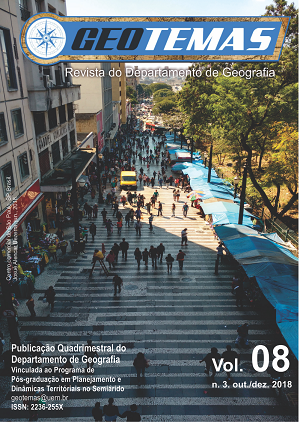La industria del bordado y la producción del espacio urbano en Maranguape - CE
Palabras clave:
La industria, El espacio, GeografíaResumen
Es en el distrito de Sapupara en Maranguape - CE que atentamos para la Industria del bordado y su entrelazamiento con la dimensión cultural y económica. Objetivamos analizar la producción del bordado y las consecuencias sociales, económicas, y principalmente en el espacio urbano del municipio de Maranguape, e incluso comprender las relaciones de producción y trabajo en la cooperativa en estudio; (en el caso de que se produzca un cambio en la calidad del producto). Para ello, el siguiente recorrido metodológico fue trazado: Levantamiento bibliográfico; análisis documental y estadístico; trabajo de campo y entrevistas semiestructuradas, elaboración de material cartográfico, tabulación de datos, sistematización y análisis de todo material recogido. Fue posible comprender la importancia del bordado en Maranguape, tanto por su valor afectivo y cultural como económico. Y aún, percibir cómo la inserción de la mujer en el trabajo corrobora con el mantenimiento de la hegemonía del sistema capitalista y la existencia de esa industria del bordado que representa un todo articulado del sistema capitalista, aunque regido por la lógica del trabajo cooperativo, de ayuda y beneficiamiento para todos los involucrados. Es notoria la importancia de esta investigación para la Ciencia Geográfica, una vez que esta actividad transforma el espacio geográfico al debido a la creación de diferentes fijos y al impulsar nuevos flujos, como el de las bordadoras que viene de seis barrios de diferentes distritos en el municipio y del público consumidor del bordado de diferentes partes del territorio nacional.
Descargas
Citas
AMORA, Z. B. Indústria e espaço no Ceará. In: SILVA, J. B. da.; CAVALCANTE, T. C.; DANTAS, E. W. C. (et al) (orgs.). Ceará: um novo olhar geográfico. Fortaleza: Edições Demócrito Rocha, 2005.
BRASIL. Turismo cultural: orientações básicas. 2. ed. Brasília: Ministério do Turismo, 2008.
CANCLINI, N. G.As culturas populares no capitalismo.São Paulo: Brasiliense, 1983.
CARLOS, A. F. A. Espaço e indústria.São Paulo: Editora Contexto/Edusp, 7. edição 1997.
DAVID, L. M. S. Cooperativismo e Conhecimento Institucional em Cooperativa. Fortaleza: UFC/FEAAC, 2008.
FAJARDO, E.; CALAGE, E.; JOPPERT, G.Fios e Fibras. Rio de Janeiro: Ed. Senac Nacional, 2002.
GALVíO, R. Aracati: Labirinto de Sonhos e de luz. Fortaleza. Edições SEBRAE -Ce, 2006.
HARVEY. D. Condição pós-moderna:uma pesquisa sobre as origens da mudança cultural. São Paulo: Loyola, 1994.
IBGE. IBGE Cidades:Maranguape. Disponível em: <https://cidades.ibge.gov.br/brasil/ce/maranguape/panorama> Acesso em: 17 dez. 2018.
IPECE. Instituto de Pesquisa e Estratégica Econômica do Ceará. Disponível em < http://www.ipece.ce.gov.br/ > Acesso em: 20 abr. 2018.
MENDES, M. C. Metropolização e indústria:Maranguape no contexto da região metropolitana de Fortaleza-CE. Dissertação apresentada No curso de Mestrado Acadêmico em Geografia, pela Universidade Estadual do Ceará –2015. Disponível em: http://www.uece.br/mag/dmdocuments/marilia_colares_dissertacao.pdf Acesso em: 22 fev. 2018.
MUNIZ, A. M. V. A dinâmica da indústria têxtil no espaço metropolitano de Fortaleza. Tese(Doutorado em Geografia). Programa de Pós-Graduação em Geografia,Universidade Federal do Ceará, Fortaleza, 2014.
MUNIZ, A. M. V. Produção do espaço metropolitano de fortaleza e a dinâmica industrial. In: Mercator, Fortaleza, v. 14, n. 3, p. 61-74, set./dez. 2015.
MUNIZ, A. M. V.Ceará state and the textile industry in time-space/o Ceará e a indústria têxtil no espaço-tempo/. In: Boletim Goiano de Geografia(Online), v. 36, p. 420-443, 2016.
OCB/CE -SESCOOP/CE -FECOOP NE. Relatório de Gestão 2014. Disponível em: http://cearacooperativo.coop.br/ftp/Relatorio-de-Gestao-SESCOOP-ce-2014.pdf Acesso em: 11 jan. 2018.
SANTOS, M. C. Do global ao local:a dinâmica da indústria de confecção na Região Metropolitana de Fortaleza -Ceará. XI -Encontro Nacional da Anpege, 2015. Dispinível em http://www.enanpege.ggf.br/2015/anais/arquivos/20/553.pdf Acesso em 10maio 2018.
SANTOS, M. A natureza do espaço:espaço e tempo, razão e técnica. 3. Ed. Huciteo. São Paulo, 1999.
SILVA, E. K. R. Crochê e Richelieu:Traços Culturais no Design Brasileiro. Actas de Diseño. Facultad de Diseño y Comunicación. Universidad de Palermo, 2012. Disponível em: http://fido.palermo.edu/servicios_dyc/encuentro2007/02_auspicios_publicaciones/actas_diseno/articulos_pdf/ADC101.pdf. Acesso em: 13 mar. 2018.
SILVA, E. K. R.Quando a cultura entra na moda: a merdalogização do artesanato e suas repercussões no cotidiano de bordadeiras de Maranguape. 2009. Disponível em http://www.repositorio.ufc.br/bitstream/riufc/1276/1/2009_Dis_EKRSILVA.pdf, Acesso em: 4 jan. 2018.
SEVERINO, A. J. Metodologia do trabalho científico. 24. ed. São Paulo: Cortez, 2007.
SISTEMA OCB. Agenda Institucional do Cooperativismo. Disponível em: <http://www.brasilcooperativo.coop.br/gerenciador/ba/arquivos/agenda_institucional_do_cooperativismo_2015_1.pdf> Acesso em: 11 jan. 2018.
SPOSITO, M. E.B. Capitalismo e Urbanização. São Paulo: Editora Contexto, 15. Ed., 2008.
Descargas
Publicado
Cómo citar
Número
Sección
Licencia
Los autores que envían sus manuscritos a Geotemas declaran que el trabajo es un artículo original y no ha sido enviado para su publicación, total o parcial, en otra revista científica nacional o internacional o en otro vehículo de circulación. Los autores también declaran que están de acuerdo con la transferencia de los derechos de autor del artículo referido a la revista Geotemas (Universidad del Estado de Rio Grande do Norte), permitiendo publicaciones posteriores, siempre y cuando la fuente de su publicación esté asegurada. Finalmente, asumen la responsabilidad pública del artículo, conscientes de que cualquier cargo que surja de un reclamo de terceros con respecto a la autoría del trabajo puede aplicarse a ellos.




















